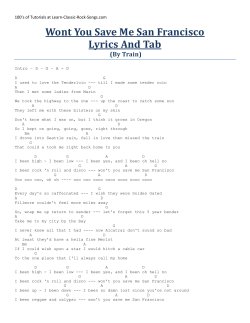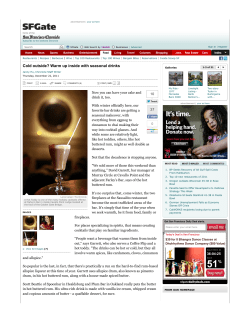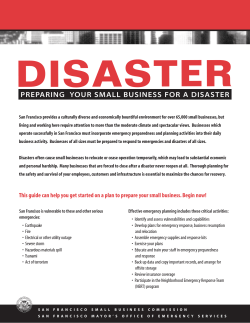
Semantic Sensor Networks: The W3C SSN-XG Ontology and
Image: Burdekin Sensor Network, Pavan Sikka & Google Semantic Sensor Networks: The W3C SSN-XG Ontology and How to Semantically Enable Real Time Sensor Feeds 4:30 – 5:20 Wed 8th June 2011 Kerry Taylor, CSIRO Australia Presented by: Kerry Taylor, CSIRO ICT Centre Kerry.Taylor@csiro.au Semantic Sensor Networks: The W3C SSN-XG Ontology and How to Semantically Enable Real Time Sensor Feeds The environmental and agricultural sciences, industrial processes and consumer gadgetry are increasingly relying on live data streams generated by large numbers of sensors to deliver knowledge and services. All the traditional problems of data management and data integration arise with real time data, plus some. Semantic technologies can help. The W3C has been developing an OWL ontology to describe sensors and sensor networks through its Incubator Group SSN-XG. I will introduce the SSN ontology, its intended purpose, and its links to other standards and technologies especially those arising from the Open Geospatial Consortium. I will also talk about some of the ways this ontology is already being used in research projects --- from improving weather prediction, to animating knives, to feeding the world. CSIRO. Semantic Technologies (SemTech 2011), San Francisco, USA, June 2011. Copyright CSIRO and many other W3C SSN-XG participants Where are they heading? Semantic Web Sensor Networks • The web of data where web content is processed by machines, with human actors at the end of the chain. • The internet of things made up of Wireless Sensor Networks, RFID, stream gauges, orbiting satellites, weather stations, GPS, traffic sensors, ocean buoys, animal and fish tags, cameras, habitat monitors, recording data from the physical world. • Today there are 4 billion mobile sensing devices plus even more fixed sensors. The US National Research Council predicts that this may grow to trillions by 2020, and they are increasingly connected by internet and Web protocols. • Record observations of a wide variety of modalities: but a big part is time-series‟ of numeric measurements. • The Open Geospatial Consortium has some web-service standards for shared data access (Sensor Web Enablement). • Goal is to open up access to real-time and archival data, and to combine in applications. • The web as a huge, dynamic, evolving database of facts, rather than pages, that can be interpreted and presented in many ways (mashups). • Fundamental importance of ontologies to describe the fact that represents the data. • RDF(S) emphasises labelled links as the source of meaning: essentially a graph model . A label (URI) uniquely identifies a concept. • OWL emphasises inference as the source of meaning: a label also refers to a package of logical axioms with a proof theory. • Usually, the two notions of meaning fit. • Goal to combine information and services for targeted purpose and new knowledge. CSIRO. Semantic Technologies Conference (SemTech 2011), San Francisco, USA, June 2011 So, What is a Semantic Sensor Network? • Reduce the difficulty and open up sensor networks by: • • • • • • Allowing high-level specification of the data collection process; Across separately deployed sensor networks; Across heterogeneous sensor types; and Across heterogeneous sensor network platforms; Using high-level descriptions of sensor network capability; and Interfacing to data integration methods using similar query and capability descriptions. • To create a Web of Real Time Meaning! CSIRO. Semantic Technologies Conference (SemTech 2011), San Francisco, USA, June 2011 The W3C SSN-XG • Commenced 1 March 2009. • Chairs: • Amit Sheth, Kno.e.sis Lab, Wright State • Kerry Taylor, CSIRO • Amit Parashar -> Holger Neuhaus -> Laurent Lefort, CSIRO • Two main objectives: • (a) the development of ontologies for describing sensors, and • (b) the extension of the Sensor Model Language (SensorML), one of the four SWE languages, to support semantic annotations. • (add charter pic and url) CSIRO. Semantic Technologies Conference (SemTech 2011), San Francisco, USA, June 2011 SSN-XG Members • 39 people from 20 organisations, including • Universities in • US, Germany, Finland, Spain, Britain, Ireland • Multinationals • Boeing, Ericsson. • Small companies • in semantics, communications, software • Research institutes • DERI (Ireland), Fraunhofer (Germany), ETRI (Korea), MBARI (US), SRI International (US), MITRE (US), US Defense, CTIC (Spain), CSIRO (Australia), CESI (China) CSIRO. Semantic Technologies Conference (SemTech 2011), San Francisco, USA, June 2011 The SSN Ontology • OWL 2 DL ontology • Edited by Michael Compton • Authored by the XG participants • Driven by Use Cases • Terminology carefully tracked to sources through annotation properties CSIRO. Semantic Technologies Conference (SemTech 2011), San Francisco, USA, June 2011 The SSN Ontology • Capabilities and properties of sensors • Measuring capability, operating conditions, survival conditions • • • • Sensors in systems, including aspects of deployment The act and method of sensing The results of sensing Aligned to (imports) DUL Offers: • A sensor view, with a focus on what senses, how it senses, and what is sensed; • A data view, with a focus on observations and metadata; • A system view, with a focus on systems of sensors; or, • A feature view, with a focus on physical features, properties of them, what can sense them, and what observations of them are made. CSIRO. Semantic Technologies Conference (SemTech 2011), San Francisco, USA, June 2011 SSN Ontology CSIRO. Semantic Technologies Conference (SemTech 2011), San Francisco, USA, June 2011 Sensor • A sensor can do (implements) sensing: that is, a sensor is any entity that can follow a sensing method and thus observe some Property of a FeatureOfInterest. Sensors may be physical devices, computational methods, a laboratory setup with a person following a method, or any other thing that can follow a Sensing Method to observe a Property • Same as „sensor‟ in OGC‟s Sensor ML, • Similar to 'observation procedure' in OGC‟s O&M CSIRO. Semantic Technologies Conference (SemTech 2011), San Francisco, USA, June 2011 Measurement Capability • Collects together measurement properties (accuracy, range, precision, etc) and the environmental conditions in which those properties hold, representing a specification of a sensor's capability in those conditions. • The conditions specified here are those that affect the measurement properties, while those in OperatingRange (of a System) represent the sensor's standard operating conditions, including conditions that don't affect the observations. CSIRO. Semantic Technologies Conference (SemTech 2011), San Francisco, USA, June 2011 Observation: a social construct that provides context, linking a Stimulus to a Result • An Observation is a Situation in which a Sensing method has been used to estimate or calculate a value of a Property of a FeatureOfInterest. Links to Sensing and Sensor describe what made the Observation and how; links to Property and Feature detail what was sensed; the result is the output of a Sensor; other metadata gives the time(s) and the quality. • Different to OGC‟s O&M, in which an „observation‟ is an act or event, although it also provides the record of the event. CSIRO. Semantic Technologies Conference (SemTech 2011), San Francisco, USA, June 2011 Extension Points: Data, Platforms, Devices, Properties & Features CSIRO. Semantic Technologies Conference (SemTech 2011), San Francisco, USA, June 2011 What it doesn‟t do • • • • • • • Sensor types and models Networks: communication, topology Representation of data and units of measurement Location, mobility or other dynamic behaviours Animate sensors Control and actuation …. CSIRO. Semantic Technologies Conference (SemTech 2011), San Francisco, USA, June 2011 OGC SWE Services Annotation • Recommended technique via Xlink attributes requires no change to SWE • xlink:href link to ontology individual • xlink:role link to ontology class • xlink:arcrole link to ontology object property CSIRO. Semantic Technologies Conference (SemTech 2011), San Francisco, USA, June 2011 What is it useful for? CSIRO. Semantic Technologies Conference (SemTech 2011), San Francisco, USA, June 2011 SmartProducts • Andriy Nikolov Knowledge Media Institute, The Open University. • Project description: Developing the scientific and technological basis for building "smart" consumer products with embedded reasoning capabilities • Use of SSN: We use a set of ontologies to describe information about the product domain and the product itself, including available sensors and their observations. • e.g. Cocktail companion http://www.smartproducts-project.eu/mainpage/videos CSIRO. Semantic Technologies Conference (SemTech 2011), San Francisco, USA, June 2011 Semantic Sensor Web • Cory Henson & Amit Sheth, Kno.e.sis Center, Wright State • Project Description: aims to provide semantic annotation of sensor data and services in order to better manage situation awareness ... builds on Open Geospatial Consortium (OGC) and extends them with semantic Web technologies to provide enhanced descriptions and access to sensor data. • Use of SSN: The ontology is used to semantically annotate and analyze streaming sensor data (e.g. weather data) and publishing as Linked Data. Also, the SSN ontology is being used for the modeling and application of machine perception (presented here yesterday) CSIRO. Semantic Technologies Conference (SemTech 2011), San Francisco, USA, June 2011 Semantic Sensor Web Linking Open Data cloud diagram, by Richard Cyganiak and Anja Jentzsch. http://lod-cloud.net/” CSIRO. Semantic Technologies Conference (SemTech 2011), San Francisco, USA, June 2011 SPITFIRE: improving sensor network data management • Digital Enterprise Research Institute : Danh Le Phuoc, Myriam Leggieri, Alexandre Passant, Manfred Hauswirth • Project description: The EU-funded SPITFIRE project (http://spitfire-project.org) aims at integrating application-level protocols, software, development environments, and evaluation methodologies from the Web and the Internet of Things. •Leggieri et al, “A Contextualised Cognitive Perspective for Linked Sensor Data - Short paper”, In Proceedings of the 3nd International Workshop on Semantic Sensor Networks, CEUR-ws.org, Workshop at ISWC2010, 2010. CSIRO. Semantic Technologies Conference (SemTech 2011), San Francisco, USA, June 2011 SPITFIRE: improving sensor network data management • Enable network and protocol-agnostic end-to-end service communication • Focus on the sensor monitored real-world object • Advantage1: City Several + representation formats Raw sensor data Country, Car model, Sensor capabilities, etc. Street Becomes All Linked Data Car + Universal (machine-understandable) Representation Format • Advantage 2: • Automatic integration of new nodes into sensor networks Intelligent Middleware for Wireless Sensor Networks • EU FP7 Exalted project. • http://www.ict-exalted.eu/ • P.Barnaghi@surrey.ac.uk • The main aims are: • • • • • Managing limited power and resources Heterogeneity & Abstraction Scalability, mobility, & dynamic network topology Query Distribution & Quality of service Data Fusion • We define context of devices and their status and then use sensor device/node description to decide and manage queries and automated event processing and communication tasks. SSN Ontology in Publishing Linked Sensor Data SSN-XG annotations CSIRO. Semantic Technologies Conference (SemTech 2011), San Francisco, USA, June 2011 Payam Barnaghi, University of Surrey SemSorGrid4Env • EU FP7 project, Oscar Corcho, Raúl García Castro UPM, Kevin R. Page Uni Southampton • Specify, design, implement, evaluate and deploy a service-oriented architecture and middleware which allows application developers to build open large-scale semantic-based sensor network grids for environmental management. • enable the rapid development of thin applications (e.g., mashups) that require real-world real-time data coming from heterogeneous sensor network • use sensors for other environmental management purposes than those that they were originally • combine their real-time data with historical data from other data sources, for decision-making CSIRO. Semantic Technologies Conference (SemTech 2011), San Francisco, USA, June 2011 Also… • Provenance projects at CSIRO • Provenance at Uni Aberdeen (c.baillie@abdn.ac.uk) • Jozef Stefan Institute in Slovenia, shows data from sensors that they have deployed around their offices. http://sensors.ijs.si/ • Uni of Madrid, Spanish Met Office: http://aemet.linkeddata.es/ • 52 North : semantics-enabled sensor plug & play infrastructure and a RESTful SOS Proxy to serve linked sensor data: Krzysztof Janowicz jano@psu.edu • Marine Metadata Initiative CSIRO. Semantic Technologies Conference (SemTech 2011), San Francisco, USA, June 2011 CSIRO: Ontology-Driven Complex Event Processing in Heterogeneous Sensor Networks • Making sensor networks usable • Application environment • Demo CSIRO. Semantic Technologies Conference (SemTech 2011), San Francisco, USA, June 2011 Phenonet – Microclimate Sensing for Plant Phenomics • Phenomics: Start with a particular observable trait or phenotype and work to discover the causal gene. • With the the High Resolution Plant Phenomics Centre of the Australian Plant Phenomics Facility • To examine the influence of microclimate on test plantings intended to compare the phenotype of grain varieties • To reproduce controlled lab results in the field • Photos Carl Davies, CSIRO Plant Industry and Peter Lamb CSIRO ICT Centre CSIRO. Semantic Technologies Conference (SemTech 2011), San Francisco, USA, June 2011 Phenonet Deployment in Canberra (also Leeton) CSIRO. Semantic Technologies Conference (SemTech 2011), San Francisco, USA, June 2011 You are an Experimental Scientist…. • You want to know, immediately, if • What would you do? • A frost occurs anywhere in the field plot; • The flowers are just starting to open; • The rain has been falling continuously for 3 hours and the temp has been above 35 deg C the whole time; • • The soil moisture content at the southwest corner of the plot differs from that at the northeast corner by 80% and yet the sun is shining everywhere; • It has been raining for 12 hours but there are still some places where the 15cm-depth soil is dry. • Nothing • Ask to have the programs on the sensor nodes rewritten to get you the right data? • Write a spreadsheet and dump the data in to check, daily? • Get into GSN and write some code to do it? How long would this take? • What if you had little knowledge of the sensing technology, but you could set it up in 10 minutes yourself? And be alerted within a few seconds of the event occurring? CSIRO. Semantic Technologies Conference (SemTech 2011), San Francisco, USA, June 2011 How does it work? •User interface •Semantic Event Middleware •CEP Server •Device-specific Management Modules CSIRO. Semantic Technologies Conference (SemTech 2011), San Francisco, USA, June 2011 Complex event processing demo ClicktoPlay Plug-in to Protégé 4.0 Location, Instrument, Sensor, Triggers instances retrieved from ontology Select an observation clause, add datavalue parameters and compose with Define an alert (message, address, media) All user input is stored as ontology instances Subsumption determines if a CEP stream is already defined or a suitable program is already running Translate to CEP code: mapping is stored in ontology. CSIRO. Semantic Technologies Conference (SemTech 2011), San Francisco, USA, June 2011 More information • Taylor & Leidinger, “Ontology-driven Complex event processing” in Proc Extending Semantic Web Conference, Heraklion, Greece, May 2011, Springer • Taylor & Penkala, Using explicit semantic representations for user programming of sensor devices, Proc Australasian Ontology Workshop, Conferences in Research and Practice in Information Technology, v112, Dec 2009. CSIRO. Semantic Technologies Conference (SemTech 2011), San Francisco, USA, June 2011 Further Information • W3C SSN-XG: Incubator Group released SSN Ontology, examples, and recommendation for use with OGC SWE • http://www.w3.org/2005/Incubator/ssn/wiki/SSN • Final Report will be released in about 2 weeks (but you can see it now) • Worked examples and applications • Extensive bibliography • 4th Semantic Sensor Networks Workshop to be at ISWC October 2011, Bonn Germany • http://research.ict.csiro.au/conferences/ssn/ssn11 • Compton et al “A survey of the semantic specification of sensors” in CEUR-WS.org/Vol-522/ • Special Issue in IJSWIS: CFP any day • Google “semantic sensor networks” / “semantic sensor web” CSIRO. Semantic Technologies Conference (SemTech 2011), San Francisco, USA, June 2011 Next? • Would love to hear if you are using it. • Would love to encourage manufacturers to use it for machinereadable “datasheets” • Would like developing W3C & OGC standards to use it • Contact me if you are interested in being part of a new W3C “community group” in the area. CSIRO. Semantic Technologies Conference (SemTech 2011), San Francisco, USA, June 2011 CSIRO ICT Centre Kerry Taylor Phone: 02 6216 7038 Email: Kerry.Taylor@csiro.au Web: www.ict.csiro.au Questions? Contact Us Phone: 1300 363 400 or +61 3 9545 2176 Email: enquiries@csiro.au Web: www.csiro.au CSIRO. Semantic Technologies Conference (SemTech 2011), San Francisco, USA, June 2011
© Copyright 2025









